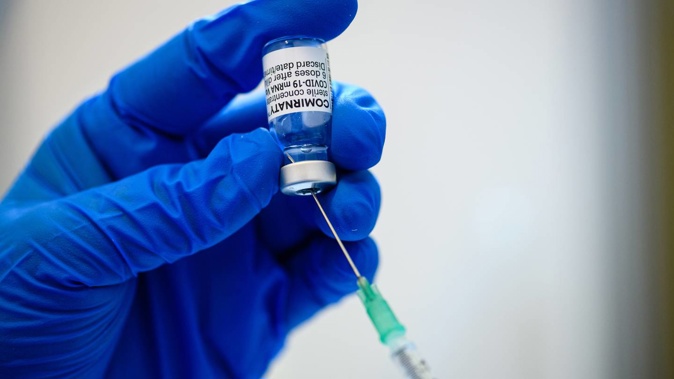
A researcher's modelling exercise has underscored a glaring gap in Omicron infection risk between the boosted and unvaccinated – something now also being illustrated by hospital cases.
In a new analysis, postdoctoral researcher Dr Leighton Watson used what's called a stochastic model to simulate the potential numbers of new infections a person could cause based on their vaccination status.
His model worked by simulating outbreaks of both Delta and Omicron, beginning with a hypothetical infection seeded by someone either unvaccinated, double-jabbed or boosted – and then running it 100,000 times.
Watson said Delta was the dominant variant when New Zealand's traffic light system was introduced, and it relied upon high vaccination rates to reduce spread.
"With the emergence of Omicron in the community in January, and evidence from overseas suggesting that the vaccine was less effective at preventing infection, I was interested in how this would impact New Zealand under the Covid-19 Protection Framework."
Overseas evidence has indicated that two doses of the Pfizer shot alone weren't very effective at stopping infection with Omicron – especially if many months had passed since the second dose was given.
While the third Pfizer dose could boost immunity significantly, Watson said the vaccine's lower performance against Omicron had led some people to believe that the vaccinated and unvaccinated were equally likely to spread the virus – and that mandates should therefore be scrapped.
That prompted him to explore what that comparative risk might look like.
"This is information that is relatively simple to get from a mathematical model, but almost impossible to determine from real data, as it is so hard to know where and who someone got infected from - especially with skyrocketing case numbers."
His model indicated that, despite accounting for just around two in 10 of all Kiwis, the unvaccinated were responsible for 45 per cent of all new Omicron infections, compared with 39 per cent for those with two doses, and 15 per cent for boosted people.
Overall, the model calculated that, when compared with boosted people, unvaccinated people were 3.1 times more likely to infect others and 2.4 times more likely to be infected.
"More interestingly, transmission from boosted-to-boosted people is only responsible for three per cent of new infections, when normalised by population," Watson said.
"So, while the vaccine provides imperfect protection against infection and transmission on an individual level for Omicron, the cumulative effect of that imperfect protection results in good protection at the population level."
While Omicron typically involved less severe illness than Delta, Watson said soaring case counts were resulting in disruption to businesses and supply chains, as well as much higher numbers of hospitalisations than we have previously seen in New Zealand.
"Not only does this impact the people who are sick in hospital with Covid, it has flow on effects with the postponement of 'non-urgent' care," he said.
"This work further demonstrates that getting boosted is important to slow the spread of Covid-19, prevent people from getting infected with Covid-19 and passing it on to friends and whanau, and help our health system cope under the onslaught of Omicron."
Rather than whether mandates should apply, Watson felt his model raised the issue of what it meant to be "fully vaccinated", given it suggested only a minor difference in infection between those who'd received two doses more than 15 weeks ago, and those who'd had none at all.
"Should being 'boosted' be required to be considered 'fully vaccinated', as being boosted is significantly more effective against infection and transmission than two doses?"
Watson stressed that his modelling came with some notable limitations and caveats.
Importantly, it didn't account for age, ethnicity and socio-economic status – nor did it model disease severity or hospitalisation risk.
As well, it assumed that a person in his hypothetical population would be just as likely to interact with any other, regardless of their vaccination status.
Professor Michael Plank, of Covid-19 Modelling Aotearoa, said accounting for age, especially, mattered when assessing infection risk in New Zealand.
"What we have at the moment is higher booster coverage in older age groups, but lower coverage in young people," he said.
"That we have lower coverage in younger age groups matters, because they are the groups where most of the cases and transmission is happening.
"That all reinforces the point that it's important to get boosted even if you're at lower risk, because the booster can cut transmission rates – particularly in those younger age groups."
Meanwhile, he said this Omicron outbreak was demonstrating the headline point of Watson's modelling: that the unvaccinated stood at much higher risk.
"The clearest trend we see now is that there's a lot more unvaccinated people ending up in hospital, compared to their proportion of the population."
Of cases in Northern Region hospitals reported as at Saturday, around 18 per cent were unvaccinated or ineligible for the vaccine, compared with 18 per cent partially immunised, 39 per cent double-vaccinated, and 20 per cent boosted.
Also as at Saturday, 95.2 per cent of the eligible population over 12 had received at least two doses, 96.6 per cent had received a single jab and 72.3 per cent were boosted.
Of 202,375 cases reported since the start of the Delta outbreak in August, there'd been 191 hospitalisations among 51,444 confirmed cases who'd been boosted at least seven days beforehand, compared with 559 hospitalisations among 11,650 confirmed unvaccinated cases.
Take your Radio, Podcasts and Music with you









